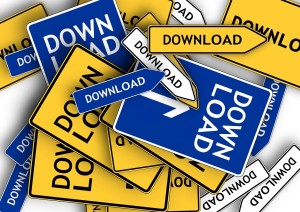How To Make Your Emails “Faster”
 Email marketing is only effective when the person receiving the message can download it to their mail reading program quickly. In an age where mobile is becoming the trending device to check emails on, the race is on to make emails faster.
Email marketing is only effective when the person receiving the message can download it to their mail reading program quickly. In an age where mobile is becoming the trending device to check emails on, the race is on to make emails faster.
There are numerous ways to increase the speed of your email messages; many of them don’t require any code and also allow messages to be read more easily on mobile devices. In an age when more emails are being read first on a mobile device compared to a desktop, this is very important.
So what are these techniques for faster emails?
1. Minimise HTML
When you are creating an email marketing message you are likely using HTML to create a stunning look. While this may create an attractive email, there are also problems with it. Every line of HTML is another line of code and chunk of memory that the receiver has to download to read your message. The more complex your code or the longer the HTML gets, the greater the memory the message will consume.
Minimising your HTML code is not difficult and there are plenty of programs out there that can help you minimise it. Alternatively, use an email marketing software system to reduce your HTML as they always have the best templates on their systems.
2. Images
Images are a major factor when it comes down to download speed. There are several aspects with images on emails that can be addressed to decrease the speed it takes to download your message.
a) Number Of Images
The more images you have on an email message the greater the memory usage. If the images are close to the top of the email copy, then these will be downloaded before the message and your audience may get bored and click off.
Also a high number of images can indicate spam and this can mean your email message is blocked from the server in the first place.
b) Size Of Images
The size of your image is of vital importance. Larger images take up loads of memory and hence longer to download and some mail clients can’t read email messages if the image is too big. The best practice is to have an image that is no bigger than 600 pixels wide, however, sometimes it is best to minimise that to just 300.
Check with your mail client whether they can do it in the program, otherwise you might have to reduce it using Paint.net or Microsoft paint.
c) Quality Of Images
Shutterstock and other stock image sites like to provide pictures and artwork of high resolution which generally take up a lot of memory. The problem is that most of your potential clients won’t have the patience to download your high quality image just to see what you’ve written at the bottom of your email.
Instead, look at lowering the quality of your image. This can be done significantly without any determinable loss to the appearance of the image.
3. Limit Content
Email marketing messages that are too long will take up a significant amount of memory. They will also be read less. Try to aim for a maximum length of between 150 and 250 words. Your main aim is to get them to your website, so have your email as an introduction rather than the entire page.
Conclusion
The speed at which your email downloads in the receiver’s mail box is vitally important. If your messages aren’t downloaded quickly, it is likely that your messages will be deleted without being read. By using the above options, you can reduce the memory taken up in the delivery of your messages to your audience’s inbox.
How fast are your emails? How big are your email messages?
Let us know in the comments.
Take Action:
- Reduce the image size on your emails.
- Minimise the HTML in your emails.
Read post Post a Comment. Tagged in: download speed, email design, mobile emails, mobile optimisation
Why Mobile-Friendly Emails Are More Important Than Ever
 The email marketing landscape is forever changing. As such, you need to be changing your tactics with the times and ensure your emails are designed with the latest best practices in mind. One of the most important best practices is mobile friendly email designs.
The email marketing landscape is forever changing. As such, you need to be changing your tactics with the times and ensure your emails are designed with the latest best practices in mind. One of the most important best practices is mobile friendly email designs.
This isn’t a new concept. For years now users have been able to read their emails online and it has helped to cement the importance of email marketing as an effective sales channel. By being able to reach customers at any time because they can access messages while out and about, the effectiveness of campaigns has grown. It has also allowed businesses to use tactics such as hurrying orders where retailers only have offers available for an hour or two before they go. Before mobile email, the majority of consumers would miss these offers.
So businesses have to consider mobile friendly emails if they want to be successful.
Growing Audience
When emails first became enabled on mobiles the uptake was poor. The devices were simply not powerful enough to connect to the internet and the cost for downloading emails was very expensive. However, technology has advanced recently to the point where reading an email on a mobile device is just as easy as reading an email on a desktop. This is why more people are now reading their emails first on their mobile devices.
The number of mobile devices has also expanded. Previously there were just a few devices that were compatible, now there is everything from Blackburry, iPhone and tablets that are able to connect to the internet and read emails. As more technology, like the new wrist devices, become mainstream, there will be even more options for consumers to read their emails.
Customers Like Mobile Friendly Emails
Research has shown that those who view emails on their mobile devices are very fussy. They like to have emails that are easy to read on the devices. If they aren’t mobile friendly, often they will just delete the email and not even give it a second chance on a desktop later.
At the same time, if you do optimise your emails for mobile devices the uptake of your message will be greater across all devices. Emails optimised for mobile devices tend to be simpler and require less memory. This allows them to be downloaded faster. It also focuses you on developing a strong message that doesn’t rely on a flashy image.
So How Can You Create A Mobile Optimised Email?
There are several elements to consider when creating a mobile friendly email. Here is our quick checklist for you to consider.
1. Reduce Image File Size
Views can be increased by 94% if you deliver content that contains a compelling image against one without an image. Even though technology has improved for mobile internet speed, large image files are still going to be slow to download. A delay of just one second can cost you 7% of your conversions.
So reduce your image files to reach a larger audience. You can do this by as much as 80% without affecting the quality of your image.
2. Resize Your Image
When you don’t resize an image it will look terrible on the screen and this will affect the user’s experience. A poor experience will result in a lost chance of a sale. So instead change the image properties so they are the same size as the width of a mobile’s screen.
3. Increase Button Size
It is harder to be accurate when selecting buttons on a mobile’s touch screen. To help your audience get around this you need to change the size of your call-to-action button. The recommended size is about 47-57 pixels.
4. Use Your Own Template Or Invest In A Responsive Template
There are templates out there that are responsive to the device that the email is opened up on. Using one of these will make your campaigns easier to design and deliver. However, if you can’t find one you like, you need to code your own.
Conclusion
Email marketing is a powerful sales tool, but you need to stay up-to-date with the latest trends. If you don’t, then you can lose out on potential sales that can harm your future business prospects.
Do you use mobile friendly email templates? What do you do when you receive one that isn’t optimised for email?
Let us know in the comments.
Take action:
- Optimise images on your emails for mobile devices.
- Improve call to action buttons on your email copy.
- Look at our responsive templates.
Read post Post a Comment. Tagged in: email marketing campaigns, email marketing strategy, mobile design, mobile emails, mobile optimised
Are Your Small Business Emails Optimized For Smartphones?

“Image courtesy of Stuart Miles / FreeDigitalPhotos.net”
Email marketing is constantly evolving. New trends are continuously being implemented allowing email to continue to be one of the most successful online marketing avenues. One of the current trends is the growth in emails being read on a Smartphone.
According to statistics, 90% of Smartphone owners will access the same email accounts from their device as their desktop and just under half of emails opened are viewed on a mobile device.
Emails opened on a Smartphone also have a higher percentage of unique clicks, and emails tend to be read for longer, even when compared to other mobile devices and desktops.
To take advantage of this trend you need to ensure that your email design is optimised so that it can be read on a Smartphone. Here are some of the design elements you can use to ensure this.
1. Restrict Your Use Of Images
Keeping your emails clear of excessive image use is an important aspect for mobile-optimized email campaigns. Using too many images means it takes longer for the email to load on the phone and the potential customer will click off your email before they’ve read it.
Use one relevant image for the email. Ensure that it is not too big either, or you’ll suffer the same problem.
2. Have a Responsive Template
If you are using a predesigned template, then make certain the design is responsive. A responsive design will automatically adjust the view so it fits the screen it is being viewed upon, whether a desktop, tablet or Smartphone.
3. Watch Your Words
Some phones will only display a certain length of the subject line. Therefore you have to ensure your subject line is less than 30 characters. If you have to have a longer title, make the key components of the title within those first few characters.
Some phones will also give more priority to the “from” label. There is little you can do about this apart from to make sure your emails are being sent from an email address which has a name attached to it. Sending emails from a Sales@ or customerservice@ often get opened less, no matter what device is currently being used.
4. Body Text
The body of your email also needs special attention paid to it. Shorter paragraphs are easier for the reader to digest and because your reader is likely to be on the go, have the key points mentioned at the very beginning. Otherwise your message could be forgotten when they are distracted by something going on around them.
5. Linking
Links on phones can look rather clumsy. Reduce the amount of links to just two. These links should not be close together as this can be distracting and reduce the click-through rate.
6. Use Buttons
Because most Smartphones have touch screens; create links to content using buttons rather than in-text hyperlinks. This is far easier for the user to select the link they want. To aid this, have significant space around the button to avoid the user clicking upon the wrong item.
7. Link To Mobile Friendly Websites
Any link needs to direct the reader to a mobile friendly site. Otherwise your reader will be disappointed with a poor looking site and will take no further action with your brand.
Conclusion
Having a mobile friendly email is not a difficult task, keep elements simple and strip down most of the advanced features that were once a trend. A quality email designed for mobile, with the rise of users accessing their emails online, will allow you to achieve more from your campaigns.
Take Action:
- Have a look at your last few emails and see if there are improvements you can make to ensure your emails are Smartphone friendly.
- Test your new email design to see how it looks on a Smartphone.
Read post Post a Comment. Tagged in: email design, email marketing, Email Newsletters, mobile emails, Small Business